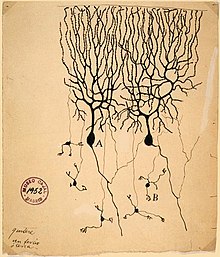Peter F. C. Gilbert
Peter Francis Cecil Gilbert | |
|---|---|
| Born | 7 July 1944 |
| Nationality | British |
| Education | RGS, Newcastle upon Tyne |
| Alma mater | |
| Scientific career | |
| Fields | |
| Institutions | |
Peter Francis Cecil Gilbert (born 7 July 1944) is an English neuroscientist and biophysicist. He is known for his pioneering work on motor learning in the cerebellum.[2][3][4]
Early life and education
[edit]Gilbert was educated at the Royal Grammar School, Newcastle upon Tyne.[5] He went on to attend Gonville and Caius College, Cambridge on a college scholarship, graduating in 1966 with a degree in natural sciences. Remaining in Cambridge, he pursued a PhD at the MRC Laboratory of Molecular Biology, under the supervision of Aaron Klug, researching the structure of tobacco mosaic virus protein.[6][7][8]
Career and research
[edit]Upon finishing his PhD in 1970, Gilbert continued his research at the MRC Laboratory of Molecular Biology as a staff scientist.[9] During this time, Gilbert developed Simultaneous Iterative Reconstruction Technique (SIRT) – an iterative method for reconstructing the three-dimensional structure of objects from two-dimensional projections.[10] The original SIRT, as proposed by Gilbert, along with the family of variants that it spawned (known as SIRT-like), have widespread applications across medicine and biology, such as CT scans and cryo-EM.[11][12][13]

In 1974, Gilbert moved into the field of neuroscience, joining the laboratory of Sir John Eccles at the State University of New York, Buffalo as a visiting professor, where he investigated the neurophysiology of the monkey cerebellum.[14] Towards the end of 1974 and after completing his work in the Eccles laboratory, Gilbert partnered with Dr W. T. Thach at Yale School of Medicine. Over the next two years, and later, at Washington University School of Medicine, the pair carried out pioneering work on cerebellar motor learning.[4] By recording from the Purkinje cells of conscious monkeys learning a manual task, Gilbert and Thach tested and confirmed theoretical predictions[2] on motor learning in the cerebellum.
Besides his experimental work, Gilbert has produced a number of theories on cerebellar motor learning and has published his theories in Nature[3] and other journals. Since 2000, he has expanded his focus from the cerebellum to the entire brain;[15] he is currently devoting his time to producing a unifying theory of brain function.
Personal life
[edit]Gilbert is the great-grandson of Sir Alfred Gilbert, the foremost member of the New Sculpture movement, and the nephew of Stephen Gilbert. He married twice and has four children.
See also
[edit]References
[edit]- ^ Peter F. C. Gilbert publications indexed by Google Scholar
- ^ Jump up to: a b Gilbert, Peter F.C. (April 1974). "A theory of memory that explains the function and structure of the cerebellum". Brain Research. 70 (1): 1–18. doi:10.1016/0006-8993(74)90208-X. PMID 4822046.
- ^ Jump up to: a b Gilbert, Peter (April 1975). "How the cerebellum could memorise movements". Nature. 254 (5502): 688–689. Bibcode:1975Natur.254..688G. doi:10.1038/254688a0. PMID 1124123. S2CID 1498910.
- ^ Jump up to: a b c Gilbert, P.F.C.; Thach, W.T. (June 1977). "Purkinje cell activity during motor learning". Brain Research. 128 (2): 309–328. doi:10.1016/0006-8993(77)90997-0. PMID 194656. S2CID 40799652.
- ^ Medcalf, Jane (2017). "Old Novocastrians Magazine" (PDF). No. 100. Royal Grammar School, Newcastle upon Tyne. p. 16. Archived from the original (PDF) on 10 November 2017. Retrieved 2 October 2020.
- ^ Leberman, R.; Finch, J.T.; Gilbert, P.F.C.; Witz, J.; Klug, A. (June 1974). "X-ray analysis of the disk of tobacco mosaic virus protein: I. Crystallization of the protein and of a heavy-atom derivative". Journal of Molecular Biology. 86 (2): 179–182. doi:10.1016/0022-2836(74)90010-2. PMID 4416913.
- ^ Finch, J.T.; Gilbert, P.F.C.; Klug, A.; Leberman, R. (June 1974). "X-ray analysis of the disk of tobacco mosaic virus protein: II. The packing arrangement in the crystal". Journal of Molecular Biology. 86 (2): 183–192. doi:10.1016/0022-2836(74)90011-4. PMID 4416914.
- ^ Gilbert, P.F.C.; Klug, A. (June 1974). "X-ray analysis of the disk of tobacco mosaic virus protein: III. A low resolution electron density map". Journal of Molecular Biology. 86 (2): 193–207. doi:10.1016/0022-2836(74)90012-6. PMID 4416915.
- ^ Huxley, Hugh (2013). Memories and Consequences. Cambridge, UK: The Medical Research Council Laboratory of Molecular Biology. p. 204. ISBN 978-184831-646-1.
- ^ Gilbert, Peter (July 1972). "Iterative methods for the three-dimensional reconstruction of an object from projections". Journal of Theoretical Biology. 36 (1): 105–117. Bibcode:1972JThBi..36..105G. doi:10.1016/0022-5193(72)90180-4. PMID 5070894.
- ^ Koning, Roman I.; Koster, Abraham J.; Sharp, Thomas H. (May 2018). "Advances in cryo-electron tomography for biology and medicine". Annals of Anatomy - Anatomischer Anzeiger. 217: 82–96. doi:10.1016/j.aanat.2018.02.004. hdl:1887/79918. PMID 29526767.
- ^ Gregor, Jens; Benson, Thomas (July 2008). "Computational Analysis and Improvement of SIRT". IEEE Transactions on Medical Imaging. 27 (7): 918–924. doi:10.1109/TMI.2008.923696. PMID 18599397. S2CID 23128639.
- ^ Herman, Gabor T. (2009). Fundamentals of computerized tomography : image reconstruction from projections (2nd ed.). Dordrecht: Springer. p. 233. ISBN 978-1-84628-723-7.
- ^ Allen, G.I.; Gilbert, P.F.C.; Yin, T.C.T. (June 1978). "Convergence of cerebral inputs onto dentate neurons in monkey". Experimental Brain Research. 32 (2): 151–70. doi:10.1007/BF00239724. PMID 210029. S2CID 28418942.
- ^ Gilbert, Peter F.C. (August 2001). "An outline of brain function". Cognitive Brain Research. 12 (1): 61–74. doi:10.1016/S0926-6410(01)00035-0. PMID 11489610.
